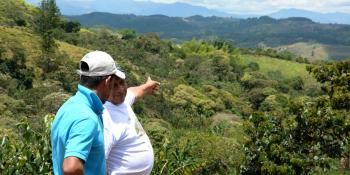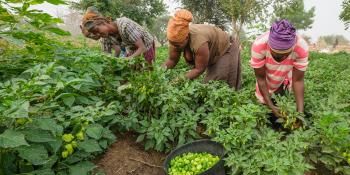Dotting your I's and crossing your T's for a transformation in food systems

Earlier this month, the United Nations Secretary-General, António Guterres warned us, “Our food systems are failing, and the COVID-19 pandemic is making things worse”. The state of our food systems has been a cause of grave concern in recent times. This is not only due to the challenges of feeding a growing population under a changing climate, but also due to rising inequities within the system. It is in this context that the World Bank and the CGIAR Research Program on Climate Change, Agriculture and Food Security (CCAFS), partnered with other likeminded institutions in the Transforming Food Systems Under a Changing Climate initiative, to explore ways to achieve sustainable, inclusive, healthy and climate-resilient food systems, mobilizing knowledge and catalyzing action.
Join the discussion on “Implementing policy and institutional changes that enable transformation,” part of the A new era for food and climate virtual event on 25 June. |
|---|
A cornerstone to catalyzing a transformation in food systems is policy and institutional change, which can lead to improved socio-economic outcomes for resource-poor rural communities. But, what do policymakers need to know at the national level in order to take action? We looked into the Climate Smart Agriculture Investment Plan series (CSAIPs) which have now been completed in over ten countries to identify 5 I’s and 4 T’s for policymakers to catalyze a transformation in food systems:
1. Build stronger Institutions to support policy change and implementation. This includes strong research institutions, farmer organizations, agribusinesses, and financial institutions, together with multi-stakeholder platforms that enable effective coordination among institutions. Institutions need to be fit for purpose, able to operate in alignment across landscapes and along food value-chains rather than conforming to traditional silos.
2. Provide better Incentives to address limited credit availability and inefficient supply chains, while also implementing innovative finance mechanisms and putting in place safety nets. A key opportunity in this respect is redirecting existing public support for agriculture (estimated at US$570 billion/year for food producers in 51 countries analyzed by the Organisation for Economic Co-operation and Development (OECD)) to incentivize climate action in agriculture and the broader food system, especially for farmers to invest in healthy soils.
3. Make private sector Investments in agriculture and food more inclusive, nutrition-informed, and environmentally friendly. In this respect, there is a need to go beyond voluntary guidelines towards binding business standards, based on widely agreed benchmarks. Public-private partnerships and de-risking facilities could play an important role in facilitating this transition.
4. Accelerate Innovation in agriculture with a focus on unlocking productivity, resilience and mitigation opportunities in simultaneous fashion, “the triple-win”. Since solutions typically do not come as blue-prints or silver bullets, but tend to be part of larger packages that are context-specific, it is important to ensure that innovation is truly farmer-centric through effective feedback loops that communicate farmer demand upstream and gauge market dynamics of downstream actors, while modernizing technology transfer through greater use of digital technologies and an expanded role of the private sector. In this respect, pay-for-results prize competitions to incentivize, or “pull” the private sector to overcome agricultural market barriers by investing in innovative research and delivery solutions that improve the lives of smallholder farmers, should be considered as a possible pathway to speed up innovation in agriculture.
5. Provide Information by unlocking the potential of digital technologies to empower farmers to make more robust decisions through:
- Tools to enhance productivity, input-use efficiency, and to manage risks more effectively, including for precision agriculture and advisories providing early warning for extreme weather events.
- Transparency in price discovery to enable farmers to get better prices.
- Technology transfer to bring new techniques of production and storage more effectively to farming communities.
- Traceability of food to reduce the distance between producers and consumers and to enable consumers to exercise the power of choice to promote sustainable practices.
While COVID-19 has pushed the world into an unprecedented crisis, with every crisis comes an opportunity. As the Secretary-General noted, “We have an opportunity to build a more inclusive and sustainable world. Let us build food systems that better address the needs of food producers and workers. Let us provide more inclusive access to healthy and nutritious food so we can eradicate hunger. And let us rebalance the relationship between food systems and the natural environment by transforming them to work better with nature and for the climate.”
Now is the moment to transform food systems, let’s dot our I's and cross our T's to make this a reality.
This blog is part of a series for the Transforming Food See details and register here. |
Read more:
- Website: Transforming Food Systems Under a Changing Climate
- Blog: It’s time to redefine what it means to be a farmer in the 21st century
- Brief: Realigning Agricultural Support to Promote Climate-Smart Agriculture
- Brief: Submission to the United Nations Framework Convention on Climate Change | Improved nutrient use and manure management towards sustainable and resilient agricultural systems
Photo: D. Brazier (IWMI)




